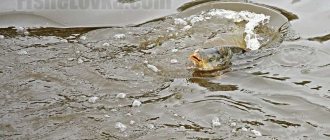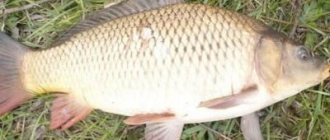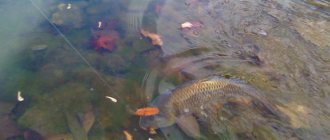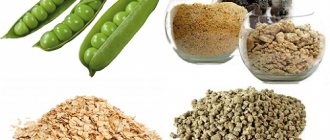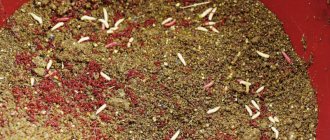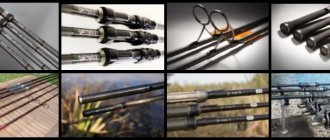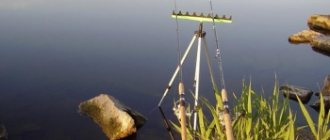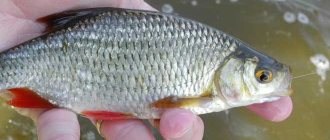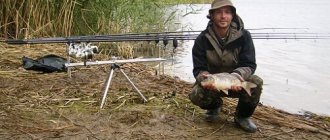Catching carp in the spring is a kind of lottery. To get a lucky ticket, you need to appear on the pond at the right time. While the water is cold, you can’t count on a bite from this heat-loving fish.
Temperature indicators greatly influence her appetite, so she will be pleased with the first bites only after the water warms up to 10-12 degrees. But the cold does not stop carp fishing lovers, because they have been waiting for this moment all winter. Avid carp anglers know that there are some exceptions to the “warm water” theory. For example, in reservoirs with a sandy bottom, carp do not hibernate in winter, they can bite even in January, and begin to actively feed in early spring. Scaly carp are the first to go looking for food. Mirrorfish prefer warmth; they are in no hurry to leave the depths and begin feeding much later.
Where to catch carp in spring
It is clear that the shallow coastal zone warms up first, so fishing for carp in early spring can allow you to catch a trophy near the shore. This is where this fish rushes at the end of March and until the beginning of May. Here, in a well-warmed shallows, she has the opportunity to prepare for spawning (accelerate the maturation of eggs), and at the same time refresh herself and restore strength after a long hunger strike. However, the appearance of a fished object in small areas does not mean that it will definitely bite. It is possible that he has only one goal - to improve living conditions, so he came here solely for warmth and oxygen.
Also in early spring, carp are attracted to overgrown areas in river bays and lakes. It can stay close to the wall of last year's reeds or even go into the very thick of dry plants. This choice is explained by the fact that after wintering the fish have a need to clean their scales and free them from adhering parasites. In addition, the underwater parts of plants are always full of natural food - insects, larvae, worms, mollusks and other living creatures. In such places it is difficult to get close to the carp with a fly rod; at the slightest rustle or quiet splash, it will move away to a safe distance. Therefore, you should not strain him with your presence; it is better to try to get the fish from the opposite bank with a match or on the feeder.
At the end of May, when the upper layers of water are already well warmed up, the carp gradually moves away from their spring feeding areas and spreads throughout the reservoir. The higher the temperature, the deeper it sinks. Finding it is now becoming more difficult. At this time, deep snags and holes, the bottom of which is covered with shells, should be considered promising.
Fishing for carp in the spring on ponds, especially protected ones that do not suffer from the outrages of poachers, can be very effective. Small carp ponds “wake up” before rivers and large lakes. There are a lot of fish here and competition forces them to feed actively.
Features of spring carp fishing
Spring fishing for carp is an activity that requires a lot of patience, endurance and professionalism, since the fish is not active, bites sluggishly, and it is not easy to catch it. As the water warms up, carp activity begins to increase. The peak of activity occurs during the period when the water warms up to +14ºС , then a good carp bite is observed. Usually, the water warms up intensely when the weather is warm outside for several days.
After a long stay of the fish in conditions of lack of oxygen, the carp first of all engages in saturating it, and only then, feeling a surge of strength and energy, proceeds to the process of searching for food. On ponds where there is no current and the lack of oxygen is more critical, the bite begins later, by about 3-4 weeks. If in winter you make holes to allow oxygen to reach the upper layers of water, then the bite may begin a little earlier.
Float fishing
Most of the spring, carp prefers to stay close to the warm surface and during this period it does not offer strong resistance when fishing, so it would be wiser to hunt for it with delicate float tackle. It is better to opt for a Bolognese fishing rod, the versatility of which allows you to fish both close to the shore and at some distance from it. It may consist of the following elements:
The rod is a carbon fiber telescope 5-8 meters long (the longer the blank, the further and more accurately you can cast the bait).- An inertia-free reel with a low gear ratio, allowing you to quickly reel in the line and retrieve the prey. It is advisable to set the friction brake in advance.
- The main line is monofilament or thin braid. Braid is not well suited for Bolognese tackle, but it has its advantages. You can use a cord that is an order of magnitude thinner than monofilament and not scare the carp; in addition, it is more reliable in terms of strength.
- The bite alarm is a not too flashy float with a carrying capacity of 0.8 to 3 g. Considering the caution of the target in spring, it is better to abandon brightly colored models.
- An invisible fluorocarbon leader in the water, the length of which depends on the depth and presence of current in the fishing area.
- Lead weights in the shape of pellets.
- Hooks made of high quality thick wire. Their size can vary from 6 to 12, but we must remember that a small hook is easier to disguise with bait. Fleshy lips will prevent the carp from spitting it out.
The rigging of a Bolognese fishing rod for spring carp fishing should be as light as possible. In the classic version, approximately 60% of the weight of the load is fixed closer to the float, and the remaining 40% is carried along the line between the alarm and the leash.
The weights are arranged in the form of an inverted pyramid: the lightest at the bottom, the heaviest at the top. With properly loaded equipment, only the alarm antenna will stick out of the water. The most effective technique for Bolognese gear is slow retrieval, in which the hook with bait slowly crawls along the bottom surface. But you can go another way: feed the point, cast the fishing rod and patiently wait for the fish to approach. Sometimes the carp rises to the surface of the water and reveals itself with a characteristic gurgling sound. It is unlikely that he will take the bait thrust right under his nose, but it is still worth a try.
Equipping a float rod for carp
Any float fishing rod should include the following equipment:
- Fishing line. High-quality fishing line will help avoid breakages;
- Float with rubber cambrics. It is best to use a float with a sensitive head, which will indicate the slightest bite;
- Sinker. Install exactly as much as necessary for the float to stand in the water;
- A leash of 10-20 cm, the fishing line in which should be an order of magnitude smaller than the main one. This will help ensure that the rig is less visible in the water;
- Hook. They can be used in a variety of ways. They even produce special hooks for catching carp.
Tackle
Properly assembled tackle will help you catch carp easily. It is necessary to deliver the equipment to the fishing spot with a light swing of the rod. In this case, the casting distance should be one and a half or two rod lengths
Rod
The length of the rod will depend on the casting distance. An ordinary fishing rod has a length of 4 to 6 meters. In addition, it should be possible to install a spinning reel.
Coil
A lightweight spinning reel makes the process of carp fishing much easier.
In this case, the reel must be equipped with a sensitive friction brake.
This will help avoid line breaks.
The inertia-free mechanism, which is equipped with this part, is capable of smoothing out strong jerks of even strong carp.
This will help avoid breakage of even the thinnest equipment
fishing line
To catch carp you will need monofilament or special braided fishing line with a breaking capacity of 5 kg or more. Accordingly, the larger the carp, the larger the fishing line needs to be installed.
Leash
Most experienced anglers don't use a leader at all. It will break very easily if a large carp bites. However, you can use a fluorocarbon line leader with a diameter of 0.2 to 0.3 mm. This leash can withstand a load of up to 7 kg. In addition to all this, fluorocarbon is almost invisible in water.
Hook
It is desirable that the hook has a short shank. These hooks are ideal for carp fishing. The size of such a hook should be from 10 and below, according to the international classification of hooks. Hooks with very thin wire work well. In general, the size of the hook directly depends on what kind of fish you are going to hunt.
Catching carp in spring on a feeder
Professional carp anglers use special gear for carp fishing, while amateurs limit themselves to a regular feeder. Its time comes closer to summer, when the fished object moves away from the shores. Carp is one of the strongest inhabitants of the reservoir, so the choice of gear should be approached responsibly. It must have special characteristics:
Match rod 3-4 meters long, class Medium Heavy (test up to 100 g) or Heavy (test up to 120 g). For fishing in the current, where conditions require the use of heavier feeders, an Extra Heavy class rod with a weight of more than 120 g is suitable.- Inertia-free with a convenient rear clutch and a large spool (3000-4000).
- Monofilament line with a thickness starting from 0.25 mm. Due to its stretchability, monofilament dampens the jerks of fighting carp that do not want to surrender to the angler. At the end of spring, sensitivity for carp tackle is no longer so important, so the use of braid is not justified.
- Feeders: closed, spring, frame, flat. Each option has its own advantages. The closed one is a cylinder dotted with small holes. It is intended for live feeding (bloodworms, cut worms, maggots), and is relevant at the beginning of the season. Standard bait is washed out of the spring faster, which means the fish arrives earlier. Frame feeders are more suitable for fishing in the grass; thanks to the plastic wings, they slide between the plants. The flat method feeder with a flat, weighted bottom allows you to successfully fish in heavily silted waters. After casting, it lowers the load down, with the food on top.
- Leads with a diameter of 0.16-0.2 mm. Their length depends on the installation of equipment and specific fishing conditions.
- Hooks made of high-quality material, numbers 6 to 10. Be sure to be sharp and hardened, soft hooks can be easily unbent by stubborn carp.
Choosing a fishing spot
Carp is a very restless fish. And it’s very difficult to say in which place it will bite best. It all depends on the specific conditions of the reservoir. It should be noted that carp is a schooling fish. If you get one bite, then wait for the second one.
Let us point out the main signs of a reservoir that will help you choose the right place for carp fishing:
- In shallow waters, thickets, reeds. This is where the carp most likely feeds, which means preference should be given to such places;
- Places whose depth will allow the carp to approach the very shore;
- Lateral areas of the shore edges
If the reservoir is not familiar to you, then experiment with the place for fishing. In places close to the shore with a depth of 1.5 m, there may also be large carp
It should be noted that additional noise may scare the carp away from this place and you will have to look for a new one. Therefore, be as quiet as possible.
Spring tips
In cold water conditions, the activity of carp is not at its best; it can only be seduced with animal baits: maggots, dung worms.
As the temperature rises, you can try combining them with baits of plant origin. These are pearl barley, peas, corn, steamed wheat. It will be possible to completely switch to them in late spring, when the fished object begins to feed heavily. It must be said that catching carp in spring in ponds sometimes brings pleasant surprises - this fish already in April begins to take soft plant baits like mastyrka or hominy. Among carp anglers, bait such as boilies is very popular, but in the spring they are ineffective.
Baits and attachments for spring carp fishing
Carp have their own assortment of preferred baits. The choice of bait may vary depending on the time of year.
It should be noted that in spring, carp bite most on plant baits. Although after winter he is hungry and will peck at everything. For autumn, carp will preferably choose natural animal organisms.
Let us indicate what is preferable for catching carp in summer and spring:
- Sweet corn;
- Canned green peas;
- Bread;
- Viscous dough;
- Pearl barley porridge.
Additional scented materials may be used.
However, if the weather is very hot, we do not recommend using them. In hot weather they will only scare away the carp.
In autumn, carp are not very active and are preferably caught using the following baits:
- Worm;
- Maggots;
- Large bloodworm;
- Various larvae
How to feed carp
The issue of choosing bait should be approached very scrupulously, since the feeding activity of fish at this time of year depends on many factors. First of all, it is the water temperature and weather. You should not be overzealous with the amount of food. For example, in early spring, carp can easily be overfed with just a few balls or full feeders.
Fishermen have noticed that store-bought mixtures designed for fishing in cold water work best in the spring. Their composition was developed by specialists taking into account the seasonal preferences of carp, its appetite and needs.
Despite the fairly high efficiency of branded baits, it still doesn’t hurt to dilute them with a small amount of animal components (bloodworms, maggots, crushed worms or shellfish).
As for homemade food prepared on the basis of grains, a number of requirements are put forward for it. Namely:
color – the bait should not contrast with the bottom soil;- mandatory component – animal components;
- freshness – to attract carp, as well as all other fish, you need a fresh mixture (it is advisable to prepare it the evening before fishing).
Factors favorable for fishing
Knowing the favorable factors will help you be in the right place at the right time.
Let's point out the main signs that indicate that fishing today will be successful:
- Muddy water;
- Light southerly breeze;
- Low atmospheric pressure;
- Hot weather;
The best time to catch carp is before sunrise or after sunset.
Basically, carp fishing depends on the time of day and weather.
Let us point out the main fishing methods taking into account these factors:
- Floating bait should only be fished during the day;
- They catch fish with a loaded daughter early in the morning and in the evening;
- For a floating bait without using a float or sinker;
- In autumn, carp are caught only in the afternoon;
Unfavorable factors for carp fishing are:
- Change from clear conditions to cloudy weather;
- Long rains;
- High atmospheric pressure.
Fishing process
Catching carp is a very exciting process that involves a whole competition between the fisherman and the fish. The main task of the fisherman is to wait for a bite.
There are reservoirs in which there are a lot of carp, and the bite happens one after another. Although carp is a cautious fish, out of a large number, one always bites carelessly. For experienced fishermen, this process is not interesting.
Many people believe that fishermen go fishing in order to catch a lot of fish. However, every amateur angler will tell you that the most important thing in fishing is the process!
In the process you need to: change bait, feed, carefully fish and much more. This is what is very important for a real fisherman. You can also buy fish in the store.
Groundbait and bait for carp
In the spring, you need to be very careful with bait, because the fish can get enough very quickly and you may not see any bites. During this period, the main task is to lure the carp, but not to feed it. As the water warms up, the carp's appetite increases, but before it spawns, it still won't be able to eat much. Therefore, bait should be purely symbolic and low-calorie.
As for the bait on the hook, in this case it is very important to know what the carp eat in a given reservoir. It can feed on both underwater vegetation and all kinds of mollusks, crustaceans, and worms
Therefore, the bait on the hook must be appropriate: either plant or animal origin.
In the spring, before spawning, you should not get carried away with boilies, especially large ones. It is better to give preference to smaller balls during this period. If the water has not yet warmed up, then you can use aromatic additives with the smell of garlic or ginger, and when the water is heated, sweet smells like vanilla will work well.
For bait you can prepare a mixture of:
- chopped worms
- boiled cereals (barley, corn, peas)
- bloodworm
- makuhi.
In order not to overfeed the carp, the bait should contain more components of plant origin. A bait such as a dragonfly larva is very catchy, but it is quite difficult to find. If a carp delicacy is found, then the carp hunt will be remembered for a long time.
In the spring, you can catch a trophy specimen of carp, and even with caviar, which is healthy and nutritious. At the same time, we must remember that caviar is the future fry of fish (carp), and this is at a time when fish stocks in our reservoirs are decreasing at a rapid pace. Therefore, when going fishing during the pre-spawning period, you should not forget about this. It is better to give the fish a chance to spawn and only then can you start catching it.
After spawning, the fish begins to eat heavily and the likelihood of catching a large carp increases greatly. During this period, fishing can be the most productive, and fishing when it’s warm enough outside is doubly pleasant.
In warm weather, carp prefer baits of plant origin, such as corn (boiled of course), peas, and various mastyrkas made from wheat or corn flour. Semolina is also in use, without which not a single recipe can be prepared. At the same time, semolina can be added to bait both raw and boiled. You should not neglect the preparation of bait, because the result of the entire fishing depends on it.
Main season for recreational carp fishing
Every fisherman knows that the main fishing season begins when the fish begin to spawn. This process is called spawning.
Factors to consider during the main amateur season:
- The water temperature should be between 18 and 26 degrees Celsius;
- The spawning period occurs from May to June at warm temperatures;
- When spawning Carp do not yet spawn in reservoirs, Carp actively eats everything that it considers edible;
- If the temperature drops, the bite weakens. Carp completely stops pecking in mid-autumn.
What time does carp bite best?
Carp are caught almost all year round. Carp are very susceptible to weather changes: atmospheric pressure, time of year and time of day.
Scheme of the active life cycle: spring – summer – autumn – winter.
When spring comes, the bite begins when the ice melts. The fish begin to bite after winter, receiving new energy. Spawning begins. Carp swim in the shallows to the algae, looking for food.
Carp spawning ends after two weeks and the carp becomes almost motionless, so there will not be a big catch. But when the water warms up, the fish “comes to life” and begins to bite, this process continues until the end of autumn. At night, the carp swims to where it is shallower. The carp stay there for several hours.
At dawn, they swim away to their shelters, where they cannot be reached. Carp can be caught around the clock, but this does not mean that it will bite all the time.
It must be taken into account that preparing the right place for fishing should take into account two places:
- Morning fishing;
- Daytime fishing.
Carp can be caught at completely different times.
The feeling of cold in carp is acutely developed. Such changes occur with the change of season, the carp tries to eat enough to have enough energy for the whole winter. That’s the only reason he “bites.”
Approximate carp biting time: it begins to bite from the end of August until September inclusive (in the middle and southern zone), from mid-September to mid-October - this is late winter.
In winter, fish do not waste energy. Lives in pits and does not move at all. In winter, it is very rare that when you have the opportunity to catch carp, smaller fish are often caught.
The atmospheric pressure becomes lower, then the carp begin to bite. It mainly decreases before the rainy season.
A temperature suitable for a good big catch in the summer is simply necessary, when it is not very hot and not very cold, carp do not like extremes. This weather should last for several days.
Conclusion: The best time of year for carp fishing: spring, summer, early autumn with constant temperature and decreasing pressure in the morning and evening.
Active carp biting:
- After the ice has melted;
- After spawning, i.e. from mid-May to early June;
- From August to September, until temperature changes cease to be sharp.
What does carp bite better in June?
If there was prolonged heat or cold, then the carp loses its appetite and does not crawl out of its shelter. In thunderstorms, light rain, and cloudy weather, the slave bites well. Fish may end up in streams or springs if the water in the river and lake warms up. If the weather is hot in June, the carp only come out to feed at night.
In June, carp bite almost everywhere: in ponds, lakes and rivers. Now let’s look at what exactly he bites on.
The most important thing for carp fishing in June is the right bait. The bait can be ready-made, purchased mixtures or aromatic baits and boilies prepared at home.
When preparing bait at home, you need to add sweet or vegetable aromas:
- Honey;
- Cocoa;
- Roasted sunflower seeds;
- Halva, etc.
Best attachments:
- Wheat;
- Pearl barley;
- Corn peas.
It is on them that large specimens of fish are caught.
If the water temperature drops within three days, then carp will be better caught using “meat” bait:
- Maggot;
- Worms;
- Insects (dragonflies).
Now only mine bites!
I caught this pike using a bite activator. No more fishing without a catch and no more looking for excuses for your bad luck! It's time to change everything!!! The best bite activator of 2021! Made in Italy…
MORE DETAILS
Correct fishing for crucian carp
Crucian carp does not live in open places. This is due to the fact that he has a lot of enemies among predator fish, and even when in bodies of water without a visible threat, he tries to stay close to his shelter, going out only in search of food.
Fish habitat
Where can crucian carp live:
- next to the reeds,
- in artificially created water areas (due to fallen trees and bushes),
- in open areas surrounded by aquatic vegetation,
- in depressions at the bottom of a pond or lake.
Small specimens stay close to the shore, while large ones live in the depths, visiting the shore only to search for food and for sunbathing.
Crucian carp is very timid, and when receiving a danger signal, it immediately changes its parking place. In open water, crucian carp are caught all season long using a float rod.
Catching crucian carp with a fishing rod
When catching crucian carp, experienced anglers use several methods:
- Flywheel. This method is performed with a conventional float fishing rod with blind equipment. The fishing line is selected thin; its length should not be longer than the rod. With the help of such gear, a fisherman can fish at a distance of 12 meters from the shore. This method is suitable for fishing in still water and in calm weather.
- Plug-in. To fish using this method, you need to purchase a plug rod, which includes the largest number of legs. The fishing rod is equipped with a thin fishing line and a float weighing 2 g or more. The length of the fishing line should not exceed the length of the upper leg. This method allows you to fish in any conditions at a distance of 20 meters from the shore.
- Match. For match fishing, you need to choose a special rod up to 5 meters long. The fishing rod must be equipped with guide rings and a reel with a sufficient supply of fishing line. This method allows you to fish over long distances. The float is installed as “Wagner”.
- Bolognese. The method is similar to the match method, but has a slight difference: a telescopic fishing rod is used. The Bolognese method allows you to catch crucian carp in the current.
Fishing in closed reservoirs and rivers
In the pond
In artificially dug reservoirs, crucian carp is the very first guest. This is due to its vitality and unpretentiousness.
In newly formed reservoirs, fish move around the water area in a school, coming very close to the shore. It is unpretentious in food and will bite on any bait that is offered to it.
In such places, fish can be caught using any tackle, regardless of the thickness of the fishing line or the size of the hook. Fishing can only be hindered by weather conditions, which greatly affect the quality of the bite.
In large established ponds, over time, other species of fish, both peaceful and predatory, appear, so crucian carp is forced to constantly change its place of residence. In order for there to be a bite, you need to feed the fishing spot. Complementary feeding is done for several days in a row to attract fish to the future fishing site.
Lure
For successful fishing you need to prepare a sufficient amount of bait, which is divided into 3 parts:
- Roll the first one into a ball the size of a small apple and throw it into the water.
- The second and third, if there are no bites, are used every hour, trying to get to the same place. If bites occur, the bait is thrown into the water before each cast.
On the river
It is difficult to feed fish on the river, since the feeding is carried away by the current. Therefore, you need to feed the fish at intervals of 15 minutes.
Spring and summer season
In the spring, crucian carp prefers reservoirs with quickly warming water: shallow waters, areas with a slight current.
In summer you can find him:
- In open areas of water surrounded by aquatic vegetation.
- In reservoirs with differences in depth.
The bite occurs when the water warms up to 10 degrees, but it is sluggish, the fish takes the bait reluctantly, but at a temperature of +15, an active hunger begins.
Crucian carp feels safe in water with a temperature of 18-25 degrees. These indicators will lead to successful fishing.
Many avid fishermen are sure that in the spring crucian carp are interested in bait from 10 a.m. to 5 p.m. In summer, the bite occurs before sunrise and in the evening after 17:00. These are all myths, since everything depends on the food supply and the size of the reservoir. If the crucian carp does not have enough food, the bite can last all day until sunset.
For a good bite, you need to take a responsible approach to the choice of bait and attachment, as well as correctly assemble the equipment.
Crucian carp is unpretentious in food. It can take both plant bait and animal bait.
